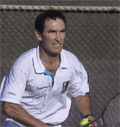Playing Winning Doubles:
Service Games
By Allen Fox, Ph.D.
Why is it that you see successful doubles teams regularly beat players that they would have no chance against in singles?
In singles you might see a player stay on the baseline hitting moonballs and lobs, but in doubles he goes to the net on every ball and he wins matches.
Why is it that good singles and good doubles players often seem to be two different animals?
The answer is that singles and doubles are different games, different in fundamental, geometric ways. If we stop to think about these differences we can learn to play smart doubles and take strategic advantage of the differences.
A tennis court is 27 feet wide on the baseline from single sideline to single sideline. The doubles alley adds another four and half feet on either side. So that's an extra nine feet total, making the width of the doubles court 36 feet.
Since each partner covers only half the court, this means each is responsible for covering only 18 feet, versus 27 feet in singles. That's a third less court to cover and it makes a huge difference.
In tennis winning shots are sometimes decided by a matter of inches. Reducing each player's court by nine feet completely changes the geometric and strategic character of the game.
Because of this the first general rule in doubles is that the team at the net has the advantage. The same player who could never cover 27 feet at the net can become dominant in doubles when that number goes down to 18.
Imagine playing singles on half the court. No matter how poorly you volley your incentive to come to the net would increase dramatically, because it becomes so much harder for your opponent to pass. That in effect is what happens in doubles.
This rule governs every strategic principle of doubles starting with the serve. Serving is more of an advantage in doubles than in singles because it gives the serving team the opportunity to go to the net first on every point.
By following his serve to the net, the server establishes his team in a dominating position and gives his team a high probability of winning the point.
Positioning: Serving Team
The server's partner should stand about half way between the service line and the net and about half way between the center service line and the side line. This position should be adjusted depending on the tendency of the receiver and what he does with his returns.
If the return never hits down the line, move closer to the center of the court, reducing the area he has to hit crosscourt. If he never lobs, move in closer to the net. It's a mistake to position yourself in the same place no matter what the receivers do. Assess their capabilities and adjust.
Because the serve offers the first opportunity to go to the net, the second general rule of doubles is get your first serve in. Even if you have to hit with less pace to get a high percentage this is still to your advantage.
If the server consistently misses with the first ball, the balance shifts toward the receiver who now has the opportunity to attack and deny the serving team the net.
This is because on second serves the returner may stand in and hit returns that force volley errors from the server or intimidate him into staying back. The returner may be able to move in behind his own returns and take control of the net first.
In doubles your goal should be to get 80 to 85% of your first serves in play. But where?
Geometrically the best place to serve is down the middle in both courts. From this position it's difficult for the receiver to pass the partner at the net. It also reduces the angle on the return back to the server. Third, it enables the server's partner to poach more easily.
The wide serve, however, has its own advantages that can sometimes make it preferable depending on the opponent. If the opponent is weaker on one side the wide serve may be necessary to exploit the weaker return.
Or the wide serve may be necessary to stay away from an especially strong return on the other side. Serving wide to a clearly weaker stroke will set up easier first volleys for the server.
If the receiver rarely returns successfully down the line the wide serve can also set up poaches, because the crosscourt return travels further, and therefore gives the net man more time to move.
Serving wide is usually riskier to an opponent's forehand, which is usually hit harder and can be directed crosscourt or down the line at the last moment, and also hit more easily from the off balance positions.
The Poach
A key play in dominating the net in doubles is the ability to poach. Poaching is valuable for two reasons. The first is it wins quick points. The second is it undermines your opponent's confidence.
A receiver who is thinking about the net player darting across and hitting a volley at his partner is much more likely to miss returns. Even if you are occasionally passed down the line you will on balance win points from your own successful poaches and the errors the receivers make worrying about them.
The two keys to poaching are movement and timing. Your path should always be diagonal, across the net and forward. Ideally you want to end up very close to the net so that you can end the point quickly.
Remember that you will be out of position after the poach, so you can't afford to let your opponents get the ball back. You're committed to aggression, so volley decisively.
Timing
The second element, the timing, is also critical. The decision to poach should be made before your partner serves, but your movement should be delayed until the last fraction of a second.
This occurs after the ball has bounced on your opponent's side but before he actually strikes the ball. Your goal is to pick the right instant so that the receiver does not see you move or is unable to react.
Often the exact timing must be adjusted depending on your opponent's ability to respond to your movement. If you find you're being passed too frequently down the line, wait a fraction of a second longer. If you're crossing but not able to reach the return, leave a fraction of a second sooner.
Work to discover the timing that balances the risk of being passed with the risk of not cutting off the crosscourt return. If your initial efforts are not completely successful, don't give up and allow your opponents to relax. Keep trying.
How often should you poach? A high level team thinks about averaging one poach a service game. When the net person is content to merely guard the alley, the server is forced to cover too much ground and your opponents are more likely to return well knowing that they have nothing to fear from the poach.
The partner at net must remain a constant threat, even when he may not have planned a poach he should be alert and pick off high or slow moving returns that pass anywhere near the middle of the court.
When exactly you poach is a guessing game played with your opponents. You want to go when your opponents think you won't or when there's so much pressure that they lack the nerve to return down the line, for example, when they have break point.
Another example is immediately after you've been burned by a down the line return. Your opponent expects that you'll be suitably humbled and stay put. An immediate second poach can shake things up.
Another case is against an opponent who is returning exceptionally well. If you're rooted in place of the net the returner may stay in the groove the entire match. You're better off taking a few chances and trying to change the situation.
If you encounter a team that plays too back to defend against your service game, how should you respond? The answer is to hit as deep as you can down the middle, particularly on the first volley, until you can create an obvious opening.
On the first volley against a defending team, it's difficult to hit a severe angle, and furthermore you end up opening up the court for the defenders to pass.
The crosscourt volley gives my opponent an opening for a down the line pass. Hitting down the middle takes away the angles. It also pulls the defenders to the center. This opens up their court for your next volley.
Australian Formation
When your opponents are returning well and you're having difficulty holding serve, a good strategic option is to change to the Australian formation.
In the Australian formation the server should stand immediately adjacent to the center line. His partner lines up in front of him on the same side of the center line. The net person is now responsible for the right side of the court, and the server the left, the reverse of the conventional doubles formation.
Typically the server will hit the serve down the middle and follow the serve in as shown here. The returner must now return down the line to avoid the net man. This can produce errors since he's used to returning primarily crosscourt.
The net man can poach in the Australian formation as well, in effect daring the returner to hit down the line and then crossing to pick off the volley.
The Australian formation is slightly disadvantageous geometrically compared to the conventional formation. This is because the server has farther to travel to cover the court. The primary advantage of the Australian formation is as a surprise tactic. It reverses the normal pattern of the exchanges.
When your service games are going against you, it can break up the rhythm of your opponent's play. It can force them into a completely different pattern of exchanges and this can reverse the flow of the match.
Attitude
Your attitude at net should be aggressive. Even if you're not a great volleyer and have a tendency to be a little fearful at the net, don't allow negative defensive thoughts to stay in your mind. This leads to paralysis.
Instead, reprogram yourself with thoughts like, I want this ball, or I'm going to nail every volley I can get my racquet on. This attitude is necessary to play aggressive winning doubles.
So much for the geometry of the court and what it means when your team is serving. In the next article we'll talk about the other half of playing winning doubles: the return game.






